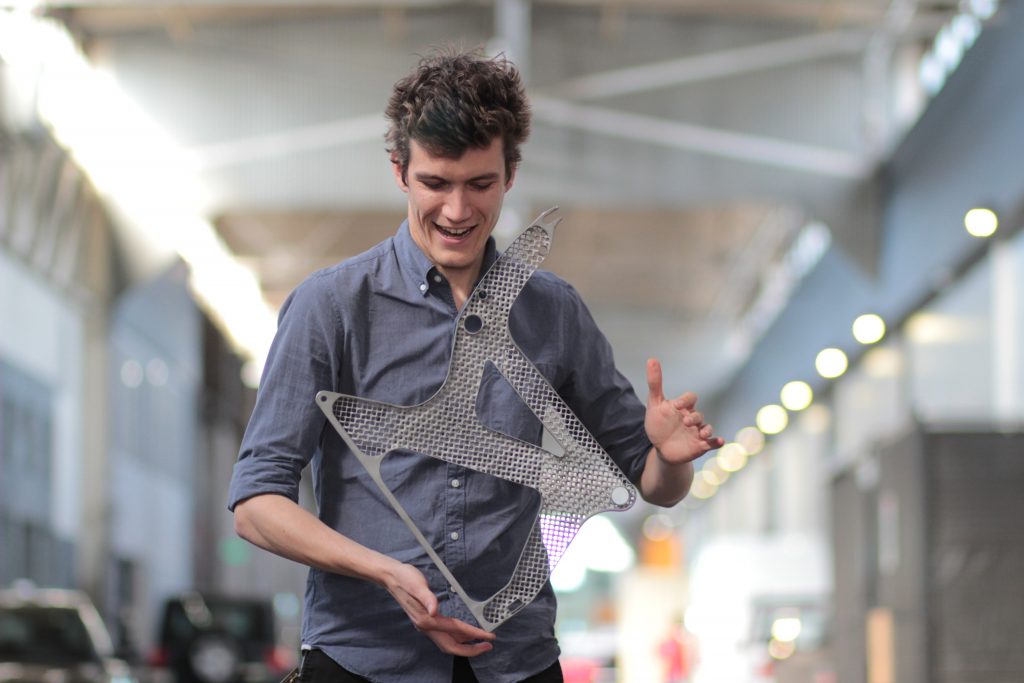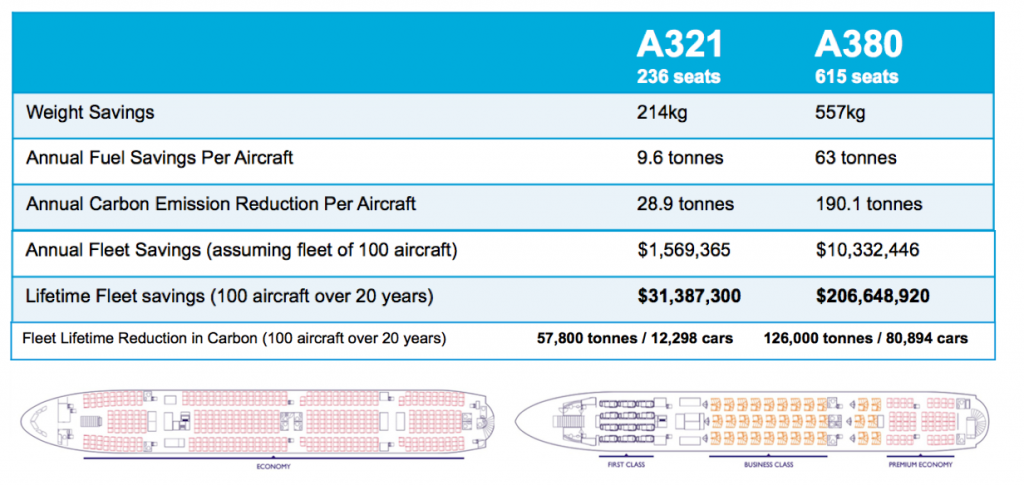At Pier 9, Autodesk’s 27,000-square foot technology center in San Francisco, research scientist Andreas Bastian has been working on a unique problem for the past year. He’s investigating how to bridge the age-old manufacturing practice of metal casting with a much newer technology: 3D printing, also known as additive manufacturing.
Why? There are a number of answers to that question. But before we dig into those reasons, it’s worth looking at the proof-of-concept project that emerged from Bastian’s work.
It’s an aircraft seat frame, suitable for any standard commercial jet. What’s different about this seat frame is that it has been light-weighted using lattice and surface optimization, meaning an algorithm in Autodesk’s Netfabb software produced the geometry to meet specified design goals. In this case, the aim was to make the seat frame just as strong as the original design, but much lighter. The resulting design is a complex structure, unlike anything a human would come up with on their own.

The benefit of this design process is that the seat frame’s lighter weight reduces the need for jet fuel—literally to the tune of millions of dollars—and lowers carbon emissions. The downside is that these complex designs can be challenging to fabricate by conventional means. In many cases, the complex geometries associated with design optimization require 3D printing.
A problem with 3D printing
Additive manufacturing is growing fast. New printers and new materials, including metals, are coming online quickly and costs are coming down. But the reality is that material options are still limited compared to traditional forms of fabrication, and the cost of 3D printing at scale is not yet competitive with conventional part production.
That brings us back to the purpose of Bastian’s research.
“While additive manufacturing holds great promise for the future of manufacturing, it’s still very new for many product developers. Casting, by contrast, has been around for millennia and is incredibly well understood. There are hundreds of thousands of engineers, foundries, and factories with deep expertise in it. That’s one of the reasons I am looking for a bridge between the two,” explains Bastian.
Bastian collaborated on the seat frame project with Andy Harris in Autodesk’s advanced consulting group. “We can generate these incredible high-performance designs, but we had to look beyond direct metal additive manufacturing for this project. The size and cost just wouldn’t work for fabricating this part,” notes Harris.
Bastian’s answer to the problem was to combine the best aspects of additive manufacturing and the casting process. Since 3D printing handles the complexity of the lattice geometry far better than other metal-forming technologies, this method was used to print positive molds or patterns of the seat frames in plastic. Bastian chose to print in plastic instead of metal because the former is a cheaper, faster, and more flexible process. The patterns were then used to create ceramic molds for casting, which provides a much more affordable way for producing the seat frames in larger quantities.
Casting offers a number of other advantages over direct metal additive manufacturing (for the near-future at least). 3D printing is now possible in a few dozen metals; casting can be done in thousands of metals and composites. So the material options are orders of magnitude greater with casting. Size is another limitation for 3D printing. Even with Autodesk’s Project Eschertechnology, print volumes are at most a few cubic feet. By contrast, casting can accommodate massive objects that weigh into the tens of thousands of pounds. Add to those advantages the better economics of casting at scale and the more widespread engineering expertise available, as Bastian noted above.
A Silicon Valley & Midwest collaboration
Speaking of which, Bastian needed just that sort of casting expertise to bring his seat frame idea to life.
Pier 9 is outfitted with all manner of 3D printer and CNC machine, but investment casting with molten metal is not on offer. So Bastian teamed up with Jack Ziemba and Paul Leonard of Aristo Cast, a foundry in Michigan. CEO Ziemba and VP Leonard jumped at the chance to collaborate on the project.
They even saw an opportunity to further reduce the weight of the seatframe: cast it in magnesium instead of the aluminum typically used for airplane seats. Magnesium casting is complicated, but it’s 35 percent lighter than aluminum, and Aristo Cast was up for the challenge.
“We leapt at the opportunity to work with Andreas and Autodesk. It’s an exciting project and allowed us to pioneer some new techniques for magnesium casting,” said Leonard. “It also gave us a chance to learn more about advanced design and optimization techniques. That’s still quite new in our industry.”

Close-up view of the complex, almost organic, lattice structure resulting from the design optimization software.
Ziemba continued, “Many foundries are reluctant to invest in additive. We see that as a big mistake. Global competition requires us to up our game. We don’t see additive as a threat to our business. On the contrary, we embrace combining the new with the 6000-year-old process of casting to produce the highest-quality parts you can find anywhere. To us, adopting new techniques like additive manufacturing, when blended with our expertise in casting, is a way forward—not just for our company but for lots of other foundries in the Midwest.”
An impressive result
Short of saving the manufacturing sector outright, what was the outcome of the Autodesk and Aristo Cast collaboration?
With the new idea to use magnesium, Bastian went back to Harris, who used the Netfabb software to re-run the simulations for the part in the new metal and confirm its properties. Bastian then sent the updated 3D model to the Aristo Cast team, who printed the pattern first in plastic resin and then coated it with ceramic to create a negative mold. Once the ceramic shell hardened, the plastic was heated and vaporized away. They then took the mold and casted the parts, initially in small quantities. But they proved it a viable process which could scale up to 160 seats every two days.

Bastian shows off how lightweight the new seat frame really is.
Extrapolating out from their prototype seat frames, Bastian teamed up with Pier 9 resident Rhet McNeal and did some eye-popping calculations. At just 766 grams, each individual seat frame is 54% lighter than the conventional 1672g aluminum seats in use today – with the design optimization accounting for 30% of the weight reduction and the magnesium accounting for the other 24%. So if an aircraft maker, say Airbus, were to replace all 615 seats on its A380 jets with the new seat frames and did it across a fleet of 100 planes which typically have a 20-year lifespan, how much money would be saved?
Bastian figures that would save the airline a whopping $206,648,920 based on average jet fuel costs in 2015. Perhaps even more consequential, the fuel reduction also translates into a reduction of 126,000 tons of C02 emissions over that same period. That’s the equivalent of removing 80,000 cars from the road for a year. [1]

Not bad. The American Foundry Society agreed that it was a pretty impressive piece of work and honored Autodesk and Aristo Cast with its Casting of the Year award in late April.
This is not the first time Autodesk has employed generative design and additive manufacturing to help airliners reduce weight, fuel consumption, and C02 emissions. The company’s The Living design studio is working with Airbus on a “bionic partition” for the interior of its A320 jets. When deployed across Airbus’s production backlog of A320 aircrafts, the company estimated it will reduce carbon emissions equal to taking 96,000 cars of the road per year. The partition is currently undergoing testing by the U.S. Federal Aviation Administration (FAA) and Airbus hopes to have them going into commercial use in the year ahead.
“Autodesk is pushing the boundaries on the light-weighting possibilities for aerospace. We see their combination of generative design, shape optimization and advanced fabrication technologies as absolutely essential to the next generation of more fuel-efficient, more sustainable aircrafts,” said Bastian Schaefer, an Innovation Manager at Airbus.
For the moment, the seat frame is still a research project—albeit one with clear commercial applicability.
“The purpose of this project was never to sell seat frames,” says Bastian. “The intent is to show the power of combining Autodesk’s advanced technologies in generative design and additive manufacturing with more a much more widely-used fabrication process: casting. Yes, there are great applications for aerospace, but this combination can also be used in automotive, medical devices, industrial equipment, and many other fields.”
“This is the kind of cutting-edge work we’re doing at Pier 9, and at Autodesk’s other fabrication facilities around the world,” says Jacob Hennessey-Rubin, a customer experience manager for Autodesk’s global technology centers. “We’re doing this kind of experimental research to show our customers what’s possible when you push the limits on software, hardware and materials. This is what’s possible when you embrace the future of making things.”
[1] Fuel calculations based on August 2015 nationwide average jet a fuel price of $5.20/gallon: http://aviationweek.com/bca/jet-and-avgas-fuel-prices-august-2015
Carbon calculations based on EPA estimated 4.7 tonnes of CO2 produced for average gasoline vehicle per year. https://www.epa.gov/greenvehicles/greenhouse-gas-emissions-typical-passenger-vehicle-0